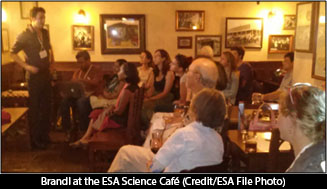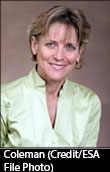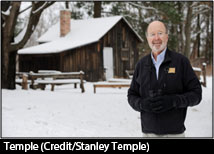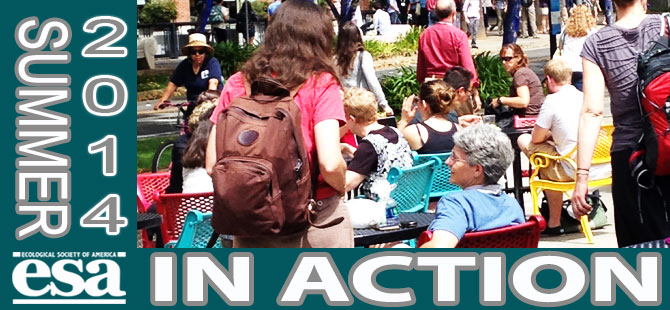 ANNUAL MEETING ANNUAL MEETING
Over 3,600 ecologists descended on Sacramento in August to attend the 99th Ecological Society of America’s 2014 Annual Meeting. Meg Caldwell who serves as executive director for the Center for Ocean Solutions and Stanford’s Law School director for Environmental and Natural Resources Law & Policy Program kicked-off the meeting Sunday night as the Opening Plenary speaker held in the historic Memorial Auditorium.
Entitled “Living in a world where 1+1=4: aligning the law, science, and practice of multiple stressors in marine ecosystems,” Caldwell's speech highlighted the importance of fostering collaboration and communication between researchers, practitioners and policymakers.
On Monday morning, the Scientific Plenary speaker, Kathy Cottingham shared a breadth of information about ecology’s role in addressing problems in human and environmental health with over 1,000 ecologists in the audience. Working as part of the Children’s Center for Environmental Health and Disease Prevention Research at Dartmouth, Cottingham and colleagues are quantifying exposure to arsenic via water and food for members of the New Hampshire Birth Cohort, a prospective cohort study that recruits pregnant women who drink water from private wells. One of the findings has shown that rice and products made from rice, such as brown rice syrup, may be quite high in arsenic and sources of exposure for the pregnant moms.
 ESA staff participated in a variety of workshops and sessions for members throughout the week. The Public Affairs Office sponsored and co-organized sessions related to conveying scientific research to policymakers, measuring the success of science communication and strategies to improve implementation of the Endangered Species Act.
ESA staff participated in a variety of workshops and sessions for members throughout the week. The Public Affairs Office sponsored and co-organized sessions related to conveying scientific research to policymakers, measuring the success of science communication and strategies to improve implementation of the Endangered Species Act.
The Science Programs Office organized a workshop centered on Intergovernmental Platform on Biodiversity and Ecosystem Services and engagement opportunities for members. The Education and Diversity Programs Office held sessions on exploring funding opportunities for undergraduate and graduate students and expanding diversity in the ecological community through the SEEDS program. The Frontier’s Office held a workshop, What Editors Want: An Author's Guide to Scientific Publishing.
 ESA Immediate Past President Jill Baron sponsored a special session on advancing ESA’s Earth Stewardship Initiative by engaging science practitioners with those in business and industry. There were also a number of sessions and Ignite talks related to the recently published third National Climate Assessment.
ESA Immediate Past President Jill Baron sponsored a special session on advancing ESA’s Earth Stewardship Initiative by engaging science practitioners with those in business and industry. There were also a number of sessions and Ignite talks related to the recently published third National Climate Assessment.
The second annual ESA Science Cafe was held at DeVere’s Pub, surrounding the University of California-Davis campus. Speakers Madhusudan Katti (Cal. State Fresno) and Simon Brandl (James Cook University - Queensland, Australia) discussed their research, which included bird populations establishing in urban settings and various fish species inhabiting the Great Barrier Reef.
National and international media entities covering the annual meeting included Capital Public Radio News, Discovery News, Huffington Post, Nature World News, Science World Report, Scientific American and Yahoo! News, among other outlets.
Speakers for this year’s Rapid Response Team luncheon shared their science and personal stories about the effects of the historic drought which now covers 100 percent of California. ESA Public Affairs Committee member, Faith Kerns who is a water analyst with the California Water Resources Institute, provided an overview of range and scope of the drought. Dan Macon of Flying Mule Farm offered a family farmer’s insight into the personal cost and financial impacts of the drought. You can read Dan’s blog The Foothill Agrarian to get a first-hand view about how local residents are persevering through uncertain times.
MEMBERS IN ACTION
 ESA President DAVID INOUYE wrote an article about his work for the local newspaper near his research site in Colorado (the Rocky Mountain Biological Laboratory) and also gave a public lecture in July.
ESA President DAVID INOUYE wrote an article about his work for the local newspaper near his research site in Colorado (the Rocky Mountain Biological Laboratory) and also gave a public lecture in July.
KAI CHAN (University of British Columbia) organized 300 scientists in signing a letter to Canada’s Prime Minister expressing concern with the Enbridge Northern Gateway project --a proposed pipeline through the Great Bear Rainforest to carry oil-tar sands (525,000 barrels of diluted bitumen and 193,000 barrels of condensate per day) 730 miles from Alberta to a port in Kitimat, British Columbia where the oil would be loaded onto 220 tankers per year headed for Asia. The scientists’ letter attracted the attention of major news outlets. He also penned an op-ed on the effort.
 FELICIA COLEMAN (Florida State University Coastal and Marine Laboratory) served on a National Academy of Sciences National Research Committee, “Value and Sustainability of Biological Field Stations, Marine Laboratories, and Natural Reserves in 21st Century Science, Education, and Public Outreach.” She participated in a web-based Q&A at the National Academy office in that was covered by Eos Transactions of the American Geophysical Union.
FELICIA COLEMAN (Florida State University Coastal and Marine Laboratory) served on a National Academy of Sciences National Research Committee, “Value and Sustainability of Biological Field Stations, Marine Laboratories, and Natural Reserves in 21st Century Science, Education, and Public Outreach.” She participated in a web-based Q&A at the National Academy office in that was covered by Eos Transactions of the American Geophysical Union.
Coleman and three other scientists provided their expertise on coastal resiliency science in the Gulf of Mexico by presenting at a Capitol Hill congressional briefing organized by the offices of Sens. Edward Markey (MA), Elizabeth Warren (MA), and Bill Nelson (FL) and Reps. Dan Lipinski (IL) and Bill Foster (IL). Her research with Chris Koenig on the threatened status of the goliath grouper (Epinephelus itajara), an 800-pound fish up to 9 feet long that lives off the Atlantic coast, was featured in a National Geographic article .
 STAN TEMPLE is using the 2014 centenary anniversary of the passenger pigeon’s extinction as a “teachable moment." He has given over 70 public presentations to date around the country about the passenger pigeon and its implications for current society as we confront the contemporary extinction crisis.
STAN TEMPLE is using the 2014 centenary anniversary of the passenger pigeon’s extinction as a “teachable moment." He has given over 70 public presentations to date around the country about the passenger pigeon and its implications for current society as we confront the contemporary extinction crisis.
ALLISON SNOW (Ohio State University) participated in a National Science Foundation workshop on research gaps for evaluating ecological applications of synthetic biology. Her concerns about using gene drive technology to suppress or eradicate wild populations of unwanted species were cited in a New York Times article by Carl Zimmer in July.
Retired ESA member BILL GREGG is working with colleagues in Ranson, WV to develop the Ranson Old Town Community Gardens --a collaborative, community-building garden initiative serving food-insecure populations through a countywide food pantry. In addition, they are providing education/demonstrations of small-scale-urban-gardening methods and edible landscaping as a local-scale example of sustainable development. The partnership, registered as a WV voluntary association, has four neighborhood garden sites and a growing number of partnering organizations and volunteers.
Correction: The Spring 2014 ESA in Action misidentified the location a scientific conference.
DON WALLER (University of Wisconsin-Madison) and KNUTE NADELHOFFER (University of Michigan) helped organize a “Confluence Conference: Great Lakes Water Levels” held at the University of Michigan-Ann Arbor in March, co-sponsored by the Environmental and Law Policy Center and the University of Michigan Biological Station. The Minneapolis StarTribune covered the event.
LETTERS AND STATEMENTS
Scientific Conferences
In July, ESA co-signed a letter with 70 other research that organizations expressing concern with S. 1347, the Conference Accountability Act. The bill includes language adding additional limits to existing travel policy regulations imposed on federal employees and contractors. In early September, ESA also sent letter of concern about the same bill to the Majority and Minority Senate leaders.
Invasive Constrictors
ESA joined members of the National Environmental Coalition on Invasive Species in sending a letter to the US Fish and Wildlife Service (FWS), requesting that FWS list the reticulated python, the DeSchauensee’s anaconda, the green anaconda, the Beni anaconda and the boa constrictor as injurious under the Lacey Act.
National Science Foundation Funding
Over the past several months, the House and Senate have each introduced their respective Fiscal Year 2015 Commerce, Justice, Science and Related Agencies appropriations bills, which includes funding for the National Science Foundation (NSF). ESA joined with the Coalition for National Science Funding in statements to House and Senate appropriators expressing support for NSF funding increases included in the two bills.
SAVE THE DATE - OPPORTUNITIES WITHIN ESA
Upcoming Conference: Life Discovery - Doing Science Education
Are you passionate about the education of our next generation? The Life Discovery - Doing Science Education conference offers more than 60 workshops and presentations on a wide range of innovative teaching ideas and engaging techniques toward Realizing Vision and Change, Preparing for Next Generation Biology. Our keynote panel will help us reflect on the changes underway in Biology Education from high school to college:
- Dr. Susan Rundell Singer, Division Director of the Division of Undergraduate Education at the National Science Foundation
- Dr. Janet Carlson, Executive Director of the Center to Support Excellence in Teaching (CSET) in the Graduate School of Education at Stanford University
- Dr. Rodolfo Dirzo, Stanford University
Advanced registration is available through September 15.
Strategies for Success: a Short Course for Project Directors
ESA’s Sustaining Biological Infrastructure (SBI) training initiative aims to provide project directors with the core business planning, marketing, and communication skills they need to ensure their resource’s success.
Our Strategies for Success short course teaches strategic planning, stakeholder analysis, effective communication, and financial management principles. These skills can help biological infrastructure project directors meet their financial sustainability goals.
Join us on our next three-day short course in Spring of 2015! For more details visit www.esa.org/sbi or email sbi@esa.org
The World Science Summit on Climate Engineering: Future Guiding Principles and Ethics
Date: 2-3 December 2014
Venue: U.S. National Academy of Sciences, 2101 Constitution Avenue, Washington DC
Background: The inability of the global community to effectively limit or roll back greenhouse gas (GHG) emissions continues to undermine the ability to minimize impacts of global climate change and has led to serious speculation about the need for engineering the climate.
Objectives of the Summit: We will engage the global scientific community, including world class men and women scientists, to bring new and innovative perspectives to the development of global principles and ethics - encompassing the potential social, ecological, and economic effects on climate engineering.
Expected Impact of the Summit: From your Summit participation and involvement, we will take the next critical step of defining what is and is not acceptable for scientists to pursue as members of the scientific community. We will create a set of guiding principles for climate engineering research.
Participation in the Summit: Please note that registration is limited. If you have any questions, please contact the CSSP office (john@sciencepres.org) or Paul Bertsch (paul.bertsch@csiro.au) of the Council of Scientific Society Presidents.
The summit is endorsed by the International Council for Science.
Communicating Climate Science Workshop
Effective scientist-communicators who foster information-sharing and respect between science and the public are essential for true public communication of and engagement with science. ESA’s Public Affairs Office in partnership with AAAS is offering a four-hour interactive Communicating Climate Science Workshop in Washington, DC on Wednesday, March 4, 2015.
While there is no charge for the workshop, space is limited. Please contact Alison Mize, Alison@esa.org for more information or to register.
|
MEMBERSHIP
ATTENTION ESA MEMBERS: Beginning in membership year 2015, dues will include membership with one section or chapter of your choice. You are still free to join additional sections or chapters.
NEW SECTIONS: There are two new ESA sections: The Disease Ecology Section will promote research and education regarding epidemiology, evolution, and ecology of host-pathogen and host-parasite (hereafter referred to as host-parasite) interactions and disease. The Early Career Ecologist Section is dedicated to supporting ecologists in the transition from student through their first few years’ full-time employment. Questions and comments can be directed to Daniel Scholes, Chair, at earlycareer@esa.org or via Twitter @esa_earlycareer.
Keep track of science and policy developments, news about your fellow ecologists and join the conversation through our Facebook page and twitter.
GET INVOLVED - ESA WANTS TO HEAR FROM YOU!
EcoTone: ESA’s blog is soliciting guest contributions about citizen science as well as posts highlighting ecology and its connections to policy and society. Contact ESA Communications Officer Liza Lester to learn about contributing a post: llester@esa.org
Podcasts: Field Talk features the field experiences of ecologists, including the work of those who have been published in the Society’s journals. For more information, contact Liza Lester: llester@esa.org. The Ecologist Goes to Washington podcast provides a venue to communicate experiences in public policy. For more information, contact ESA Policy Analyst, Terence Houston: terence@esa.org.
ESA in Action Fall 2014: If you have an interesting story about sharing your work beyond the ecological community or have been actively involved in policy or media communication, we’d like to hear from you. Please send updates to ESA’s Public Affairs Office at pao@esa.org
Keep track of science and policy developments, news about your fellow ecologists and join the conversation through our Facebook page and twitter.
|
|

 ANNUAL MEETING
ANNUAL MEETING



